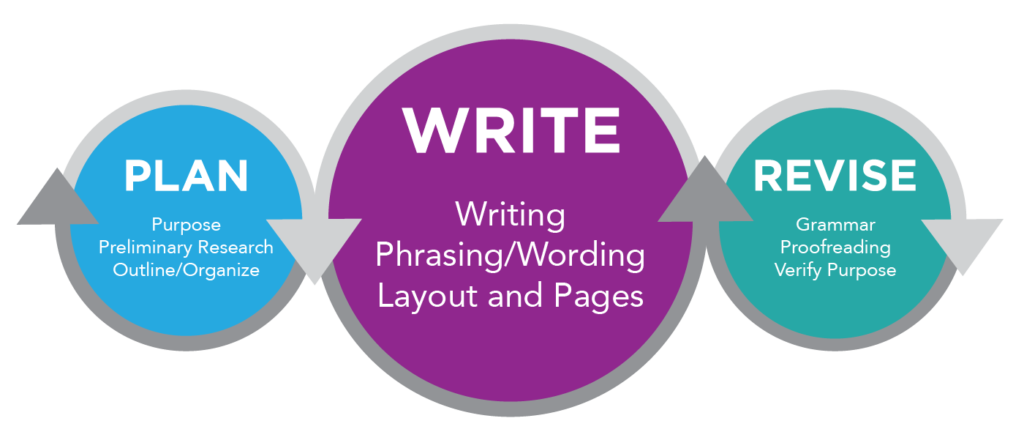Learning Outcomes
- Discuss how to write a formal report
Writing formal reports, like informal report, and that of any other writing task follows the same three steps. First is the planning. Second is the writing. Third is the revising.

Figure 1.
Planning Your Formal Report
In all business writing, the first step is to check and see whether there is a prescribed structure for the document that is about to be created. If so, follow that. Many formal reports have specific formats that must be followed exactly. For example, some sales proposal requests and responses become part of a contract; therefore, you should ensure documents such as these have a legal review both in the planning of the document and as a part of the final review step.
Other steps in preparation of a formal report follow in the same way as those for an informal report. In an informal report, however, it is less likely there will be multiple writers. With a formal report, there may be many contributors. If so, it is important to meet as a group to divide the work, talk about style, and plan how the final document will be assembled and edited to ensure a common voice or tone throughout. You may wish to consider some of the strategies discussed in Chapter 12: Collaboration in and Across Teams.
Next you’ll complete any data gathering needed. A formal report likely requires extensive planning and data gathering: some proposals may require weeks or months in researching and preparing. For example, think about a proposal for the next three years of new store locations or construction. The author (likely a team of authors) will need primary and secondary research, which takes a great deal of time to gather and analyze.
You will use knowledge of that data to create the report’s outline. In constructing that outline, again consider the depth of understanding of the reader and the likelihood the reader’s views align with that of the report’s determination.
With group writing, there may be several coordination meetings at each stage of the document’s creation.
Writing Your Formal Report
Writing the formal report is a much easier task once you have created a detailed outline in the planning process. This outline is what helps the writing move along, as you already know exactly what is to be provided where and when. When writing a formal report as a team, a carefully constructed outline facilitates assigning sections of the report to different authors from the team. The writer or writers can then focus on paragraph structure, wording, and phrasing using the lessons found in Chapter 2: Writing in Business.
With a formal report, it is extremely rare to see the casual phrasing that might be found in a short message or informal report. Formal reports rarely use personal pronouns, contractions, or passive verb structures. However, this does not mean the language should be stilted or use excessively long words. You’ll continue to use the same clarity of wording as in all business communications.
Formatting Your Report
Formal reports implement many of the formatting skills you learned earlier. Usually formal reports are single spaced with double spaces between paragraphs. Usually paragraphs are not indented, but this may vary from organization to organization. The right hand side of paragraphs are left ragged.
Section headings are always provided in a formal report. It is acceptable to use labels to match the section’s purpose (e.g., Introduction, Findings, Research Methods). The headings may also use terms directly related to the report’s purpose such as “Fruit Spoilage Problem,” “Facts about Fruit Spoilage,” “Suggestions to Improve Fruit Freshness.” You may also have specific subheadings within more general section titles.
Formal reports of all types use page numbers.The pages may be numbered in a format such as 1–50, or they may be numbered by the section, such as Methods 1–Methods 50. The material in the front part of a report is generally numbered in lowercase roman numerals (i–ix).
Revising Your Formal Report
Because of the length and possible subject complexity of formal reports, the final review takes more time than you might expect and involves more people. As mentioned in the start of this section, some reports may require additional legal review.
The most effective way to ensure a professional document is to have a team of individuals independently read the document, marking changes, corrections, and questions as they go. This team then meets as a group with one individual charged with collecting all corrections. This person ensures continuity across the entire document. If such a formal process cannot be completed, then you should work to ensure there are at least two reviewers who review work they themselves did not write.
As mentioned before, the final revision must consider both grammar and style issues as well as revisiting the primary purpose of the document.
Practice Question
Contribute!
Candela Citations
- Plan, Write, Revise Formal Report. Authored by: Susan Kendall. License: CC BY: Attribution
